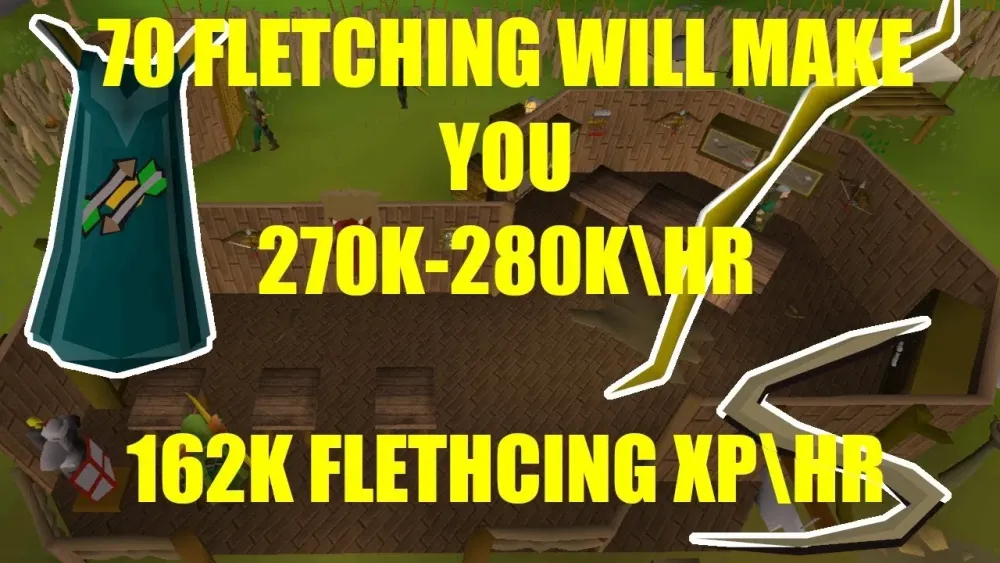Your cart is empty
Is Fletching Profitable in OSRS? A Comprehensive Guide

Fletching is a vital skill in Old School RuneScape (OSRS) that allows players to create bows, arrows, and other ranged equipment. This skill not only enhances your combat capabilities but also provides a source of income. Many players wonder about the profitability of fletching and whether it’s worth investing time and resources into. This guide will delve into the intricacies of fletching, examining its mechanics, requirements, and potential for profit.
To embark on your fletching journey in OSRS, you need to meet certain requirements and acquire specific skills. Fletching can be trained using various methods, from crafting basic wooden arrows to creating high-level bows. The skill is crucial for players who engage in ranged combat, as it allows them to craft their own ammunition and weapons, ultimately saving money and enhancing gameplay.
To start fletching, players need access to a knife and logs. The basic fletching process involves using a knife on logs to create headless arrows. As players level up, they unlock the ability to craft better items, including different types of arrows and bows, which require higher levels of the skill. For instance, creating a Maple Longbow requires a Fletching level of 55 and Maple Logs.
Aside from the basic tools like the knife, players can also benefit from having access to various locations where logs can be easily obtained, such as the Lumber Yard or the Woodcutting Guild. Additionally, players can enhance their fletching experience by using specific items like the Fletching cape, which provides a small experience boost when worn.
As you progress, understanding the market for fletched items becomes essential. The demand for arrows and bows fluctuates based on the player base and game updates. High-level bows tend to sell for more on the Grand Exchange, making them a lucrative option for experienced fletchers. However, it’s important to consider the time and resources spent on training the skill versus the potential profits made from selling crafted items.
In summary, fletching requires a combination of tools, resources, and an understanding of the market to be profitable. By strategically training the skill and keeping an eye on market trends, players can turn fletching into a reliable source of income in OSRS.
Profit Margins: Analyzing Costs and Revenues

When it comes to fletching in Old School RuneScape (OSRS), understanding your profit margins is crucial for maximizing your gains. Let’s break down the costs and revenues associated with this skill.
Costs:
- Materials: The primary cost in fletching is the materials required to craft your items. This includes logs, feathers, and any other components needed for arrows or bows. Prices fluctuate based on supply and demand, so it’s wise to check the Grand Exchange regularly.
- Tools: You’ll need a knife for fletching logs. While it’s a minimal cost, consider any potential repairs or replacements over time.
Revenues:
- Selling Finished Products: The main source of income comes from selling your crafted items at the Grand Exchange. Bows and high-tier arrows generally yield better returns.
- Experience Gains: While not a direct income, leveling up your fletching can lead to crafting higher-value items, which can significantly increase your profits.
Once you’ve gathered your data, you can calculate your profit margins using the formula:
| Profit Margin | Formula |
|---|---|
| Profit | Revenue – Costs |
By regularly analyzing these factors, you’ll be able to adjust your fletching strategies to maximize profits effectively.
Best Fletching Methods for Profit

Now that you have a handle on costs and revenues, let’s explore the best fletching methods to ensure you’re making the most out of your time and resources.
1. Arrow Shafts: Crafting arrow shafts from logs is one of the most efficient ways to start making money. They sell steadily on the Grand Exchange and require minimal investment.
2. Headless Arrows: Once you have arrow shafts, adding feathers turns them into headless arrows. This method is cost-effective and yields a good profit margin.
3. Bows: Crafting bows, especially yew and magic bows, can yield high profits. Although the initial costs are higher, the selling price often compensates for this, especially at higher levels.
4. Bolts: Fletching bolts can also be lucrative. Steel and rune bolts are in demand for players engaging in combat, making them a reliable source of income.
5. Darts: If you’re looking for something quick, fletching darts can be very profitable. They require fewer resources and can be sold rapidly.
To summarize, the best fletching methods for profit are those that balance low-cost materials with high-demand products. Always keep an eye on market trends and adjust your methods accordingly for the best returns.
Comparison of Different Bow Types and Their Profitability
When it comes to fletching in Old School RuneScape (OSRS), not all bows are created equal. Each bow type offers different levels of experience, crafting requirements, and, most importantly, profitability. Let’s break down some popular bow types to help you decide which ones to focus on.
- Shortbows:
- *Bronze Shortbow: Low cost, easy to make, but minimal profit.
- Maple Shortbow: A popular choice, with decent experience and moderate profitability.
- Magic Shortbow: Higher requirements but offers good returns.
- Longbows:
- Willow Longbow: Fairly common; offers good experience but lower profit margins.
- Yew Longbow: A staple for many fletchers, balances experience gain and profit well.
- Magic Longbow: High demand in the market, resulting in significant profit, but requires more resources.
- Special Bows:
- Dark Bow: Requires a high fletching level and has a strong market.
- Zaryte Bow:* High-end bow with excellent profitability but requires significant investment.
In conclusion, if you’re looking to maximize your profits, focus on bows like the Yew Longbow or Magic Shortbow. Keep an eye on the market trends, as prices can fluctuate based on demand and supply.
Market Trends: How to Sell Your Fletched Items
Understanding market trends is crucial for maximizing your profits from fletching in OSRS. Here’s what you need to know about selling your fletched items successfully.
- Know Your Market:
Check the Grand Exchange for the current prices of your fletched items. Prices can vary significantly based on demand and supply.
- Timing is Key:
Prices can fluctuate throughout the day. Try to sell during peak hours when more players are online.
- Bulk Selling:
Consider selling in bulk to attract buyers looking for a good deal. It can also save you time.
- Use Price Check Tools:
Utilize third-party websites or in-game tools to track price trends. This will give you an edge in understanding when to sell.
By keeping an eye on these market trends and selling at the right time, you can significantly increase your profits from fletching in OSRS. Remember, the more informed you are, the better your chances of success!
7. Tips and Tricks for Maximizing Your Fletching Profits
Fletching can be a rewarding skill in Old School RuneScape (OSRS), especially when it comes to maximizing your profits. Here are some handy tips and tricks to help you boost your Fletching profits:
- Use the Best Materials: Always opt for the highest quality logs and feathers available to you. For example, using Yew logs instead of normal logs can yield better items that sell for more.
- Utilize Fletching Experience Boosts: Consider using items like the Fletching Potion or Skilling outfit to increase your experience gain. More experience means faster leveling, which can lead to more profitable items.
- Check the Grand Exchange: Always keep an eye on the Grand Exchange prices. Prices fluctuate, and knowing when to buy or sell can significantly impact your profits.
- Focus on Popular Bow Types: Crafting bows that are frequently in demand, such as the Magic Shortbow or Yew Longbow, can lead to quicker sales.
- Level Up Efficiently: Prioritize leveling up to access higher-tier fletching options. Higher-level fletching items often sell for much more.
- Consider Making Bolt Racks: If you have access to bolt racks, they can be a great source of profit for fletchers. They require less effort and can yield a good return.
By implementing these tips and tricks, you’ll be well on your way to maximizing your Fletching profits in OSRS!
8. Common Mistakes to Avoid While Fletching
While Fletching can be a fun and profitable skill, there are some common mistakes that players tend to make. Avoiding these can save you time, resources, and ultimately, your profits:
- Not Tracking Market Prices: Failing to monitor the Grand Exchange can lead to selling your items for much less than they’re worth. Make it a habit to check prices regularly.
- Ignoring Supply and Demand: Crafting items that are not in demand can result in a surplus of unsold products. Focus on items that are consistently sought after.
- Overlooking Experience Rates: Some players rush through Fletching without considering the best experience rates. Take the time to research optimal training methods.
- Underestimating Costs: Be mindful of the costs associated with purchasing materials. Sometimes, what seems profitable initially can leave you with a loss after accounting for expenses.
- Neglecting to Use Bonuses: Many players forget to utilize experience bonuses. Always take advantage of events, potions, or gear that can enhance your Fletching experience.
- Focusing Solely on High-Level Items: While high-level items are often more profitable, they can also be time-consuming to produce. Balance your crafting between high and low-tier items.
By steering clear of these common mistakes, you’ll make your Fletching experience much smoother and more profitable!
Is Fletching Profitable in OSRS? A Comprehensive Guide
Fletching is one of the many skills in Old School RuneScape (OSRS) that allows players to create a variety of ranged weapons and ammunition. This skill involves crafting bows and darts, making it an essential part of the game for those focused on ranged combat. The profitability of Fletching can greatly vary depending on the methods and materials used.
To determine whether Fletching is profitable, consider the following factors:
- Materials Required: Fletching requires logs, feathers, and other materials depending on the item being crafted.
- Experience Rates: Higher experience rates can lead to faster leveling, allowing players to access more profitable items.
- Market Prices: The profit margins depend heavily on the current Grand Exchange prices for logs, bows, and arrows.
- Level Requirements: Higher-level items yield greater profit but require more resources and time.
Here’s a brief comparison of some popular Fletching methods:
| Item | Level Required | Profit per hour | Experience per hour |
|---|---|---|---|
| Shortbows | 5 | 50,000 GP | 30,000 XP |
| Longbows | 10 | 60,000 GP | 40,000 XP |
| Broad Arrows | 10 | 70,000 GP | 45,000 XP |
In summary, Fletching can be a highly profitable skill in OSRS, especially if players keep an eye on market trends and choose their crafting methods wisely. The ability to create high-demand items like bows and arrows means that with the right approach, you can maximize your profit while training this skill.
Conclusion: Is Fletching Worth Your Time?
Yes, Fletching can be worth your time if you focus on high-value items and stay updated on market prices, allowing you to make a significant profit while training this versatile skill.
